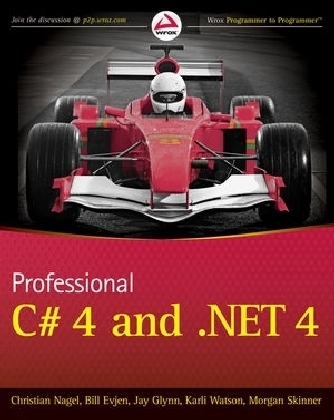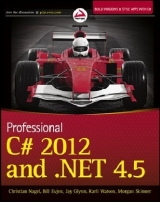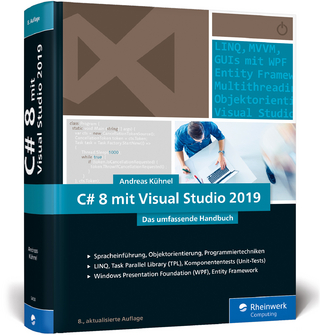
Professional C# 4.0 and .NET 4
Wrox Press (Verlag)
978-0-470-50225-9 (ISBN)
- Titel ist leider vergriffen;
keine Neuauflage - Artikel merken
This book starts by reviewing the overall architecture of .NET in order to give you the background you need to be able to write managed code. After that, the book is divided into a number of sections that cover both the C# language and its application in a variety of areas.
Part I: The C# Language gives a good grounding in the C# language for experienced programmers. You start by looking at basic syntax and data types. Objects, types, inheritance, generics, arrays, tuples, operators, casts, delegates, lambdas, events, strings, regular expressions, collections, Language Integrated, Query (LINQ), Dynamic Language Extensions, memory management, pointers, reflection, errors, and exceptions are all covered.
Part II: Visual Studio looks at Visual Studio 2010 (the best way to use the tool to build applications based on the .NET Framework 4) and deploying your projects.
Part III: Foundation looks at .NET assemblies, instrumentation, security, threading, tasks, synchronization, localization, System.Transactions, networking, interop, XAML, Managed Extensibility Framework, Manipulating Files and the Registry, transactions, building Windows services, and generating your own libraries as assemblies.
Part IV: Data covers accessing databases with ADO.NET, ADO.NET Entity Framework, data services, support in .NET for XML, and the .NET features of SQL Server 2008.
Part V: Presentation shows how to build applications based on the Windows Presentation Foundation and Silverlight, and covers writing components that will run on web sites. It also has coverage on building Windows Forms applications in as well as ASP.NET and ASP.NET MVC.
Part VI: Communication covers services for platform–independent communication using the Windows Communication Foundation (WCF). With Message Queuing, asynchronous disconnected communication is shown. This section looks at utilizing the Windows Workflow Foundation 4, peer to peer networking, and creating syndication feeds.
Christian Nagel is a Microsoft Regional Director, software architect, and author of many .NET books. He founded CN innovation and is an associate of thinktecture. Bill Evjen is Global Head of Platform Architecture for Thomson Reuters, Lipper. He is also a Microsoft Regional Director and the founder of INETA. Jay Glynn is the Principle Architect at PureSafety, a leading provider of results–driven software and information solutions for workforce safety and health. Karli Watson is a freelance author and a consultant for Infusion Development. Morgan Skinner works in premier support for developers at Microsoft.
INTRODUCTION LI
PART I: THE C# LANGUAGE
CHAPTER 1: .NET ARCHITECTURE 3
CHAPTER 2: CORE C# 23
CHAPTER 3: OBJECTS AND TYPES 65
CHAPTER 4: INHERITANCE 89
CHAPTER 5: GENERICS 107
CHAPTER 6: ARRAYS AND TUPLES 129
CHAPTER 7: OPERATORS AND CASTS 151
CHAPTER 8: DELEGATES, LAMBDAS, AND EVENTS 183
CHAPTER 9: STRINGS AND REGULAR EXPRESSIONS 207
CHAPTER 10: COLLECTIONS 225
CHAPTER 11: LANGUAGE INTEGRATED QUERY 267
CHAPTER 12: DYNAMIC LANGUAGE EXTENSIONS 295
CHAPTER 13: MEMORY MANAGEMENT AND POINTERS 307
CHAPTER 14: REFLECTION 333
CHAPTER 15: ERRORS AND EXCEPTIONS 351
PART II: VISUAL STUDIO
CHAPTER 16: VISUAL STUDIO 2010 373
CHAPTER 17: DEPLOYMENT 407
PART III: FOUNDATION
CHAPTER 18: ASSEMBLIES 431
CHAPTER 19: INSTRUMENTATION 461
CHAPTER 20: THREADS, TASKS, AND SYNCHRONIZATION 491
CHAPTER 21: SECURITY 545
CHAPTER 22: LOCALIZATION 569
CHAPTER 23: SYSTEM.TRANSACTIONS 605
CHAPTER 24: NETWORKING 637
CHAPTER 25: WINDOWS SERVICES 667
CHAPTER 26: INTEROP 695
CHAPTER 27: CORE XAML 727
CHAPTER 28: MANAGED EXTENSIBILITY FRAMEWORK 747
CHAPTER 29: MANIPULATING FILES AND THE REGISTRY 771
PART IV: DATA
CHAPTER 30: CORE ADO.NET 817
CHAPTER 31: ADO.NET ENTITY FRAMEWORK 861
CHAPTER 32: DATA SERVICES 885
CHAPTER 33: MANIPULATING XML 903
CHAPTER 34: .NET PROGRAMMING WITH SQL SERVER 955
PART V: PRESENTATION
CHAPTER 35: CORE WPF 983
CHAPTER 36: BUSINESS APPLICATIONS WITH WPF 1035
CHAPTER 37: CREATING DOCUMENTS WITH WPF 1075
CHAPTER 38: SILVERLIGHT 1095
CHAPTER 39: WINDOWS FORMS 1117
CHAPTER 40: CORE ASP.NET 1149
CHAPTER 41: ASP.NET FEATURES 1185
CHAPTER 42: ASP.NET DYNAMIC DATA AND MVC 1243
CHAPTER 43: WINDOWS COMMUNICATION FOUNDATION 1279
CHAPTER 44: WINDOWS WORKFLOW FOUNDATION 4 1309
CHAPTER 45: PEER–TO–PEER NETWORKING 1339
CHAPTER 46: MESSAGE QUEUING 1357
CHAPTER 47: SYNDICATION 1387
APPENDIX: GUIDELINES FOR WINDOWS 7 AND WINDOWS SERVER 2008 R2 1397
INDEX 1417
| Erscheint lt. Verlag | 5.3.2010 |
|---|---|
| Reihe/Serie | Wrox Programmer to Programmer |
| Sprache | englisch |
| Maße | 188 x 232 mm |
| Gewicht | 2052 g |
| Einbandart | Paperback |
| Themenwelt | Informatik ► Programmiersprachen / -werkzeuge ► C# |
| Mathematik / Informatik ► Informatik ► Software Entwicklung | |
| ISBN-10 | 0-470-50225-8 / 0470502258 |
| ISBN-13 | 978-0-470-50225-9 / 9780470502259 |
| Zustand | Neuware |
| Haben Sie eine Frage zum Produkt? |
aus dem Bereich



